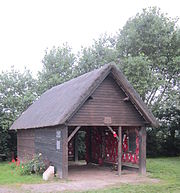| Wormhoudt massacre | |
|---|---|
 Rebuilt barn (cowshed), Wormhoudt massacre site | |
| Location | Wormhout, France |
| Date | 28 May 1940 |
| Target | British and French POWs |
Attack type | War crime |
| Weapons |
Model 24 grenades Automatic weapons |
| Deaths | 80 |
Non-fatal injuries | 15 |
| Perpetrators |
|
The Wormhoudt massacre (or Wormhout massacre) was the mass murder of 80 British and French POWs by Waffen-SS soldiers from the 1st SS Division Leibstandarte SS Adolf Hitler during the Battle of France in May 1940.
Fighting[]
As part of the retreat of the British Expeditionary Force towards Dunkirk, the 48th Division was holding the road which runs southward from Bergues through Wormhoudt, Cassel and Hazebrouck to delay the German advance.
British units at Wormhoudt were overrun by advancing German forces. Having exhausted their ammunition supplies, the troops at this point surrendered assuming that they would be taken prisoner according to the Geneva Convention.
Massacre[]
After their surrender, a large group of soldiers from the 2nd battalion Royal Warwickshire Regiment, 4th battalion Cheshire Regiment, and Royal Artillery as well as French soldiers in charge of a military depot were taken to a barn in La Plaine au Bois near Wormhout and Esquelbecq on 28 May 1940. The Allied troops had become increasingly alarmed at the brutal conduct of the SS soldiers en route to the barn which included the shooting of a number of wounded stragglers. On arrival at the barn the only British officer in the group, Captain James Lynn-Allen, protested but was immediately rebuked by an SS soldier.[1] The British officer was then shot.[2]
When there were nearly 100 men inside the barn, soldiers from the Leibstandarte SS Adolf Hitler, threw stick-grenades into the building killing many POWs. The grenades failed to kill everyone, largely due to the bravery of two British NCOs, Sergeant Stanley Moore and CSM Augustus Jennings, who hurled themselves on top of the grenades using their bodies to suppress the force of the explosion and shield their comrades from the blast.[3] Upon realising this, the SS called for two groups of five to come out. The men came out and were shot. Despite being shot, Gunner Brian Fahey survived, unknown to the SS men at the time. Concluding that these methods were too slow, the SS troopers simply fired into the barn with their weapons.[4]
Several British prisoners were able to escape, while a few others, like Fahey, were left for dead.[5] A total of 80 men were killed. After a couple of days, Fahey and several others were found by regular German Army medics and taken to hospital. Their wounds were treated before they were sent to prisoner of war camps in occupied Europe.[5]
Legacy[]
The Waffen-SS division, Leibstandarte SS Adolf Hitler was under the overall command of Oberstgruppenführer Sepp Dietrich. It was alleged from post-war testimony that it was specifically soldiers of the 2nd Battalion under the command of then Hauptsturmführer Wilhelm Mohnke that carried out the atrocity. However, Mohnke never had to face a trial for any alleged part in the war crimes based on these hors de combat killings. Mohnke strongly denied the accusations against him, telling historian Thomas Fischer, "I issued no orders not to take English prisoners or to execute prisoners."[6] Mohnke died in August 2001.
In 1947, a number of survivors of the massacre returned to the scene accompanied by officials from the War Crimes Interrogation Unit, following investigations undertaken by the office of the Judge Advocate General. It proved impossible to construct a sufficiently strong case to bring prosecutions. A number of alleged key witnesses were reported to have died on the Eastern Front, while others invoked the "SS Oath" and refused to talk.[3]
In 1988, after a campaign by British MP Jeff Rooker, the case was reopened but a German prosecutor came to the conclusion that there was insufficient evidence to bring charges.[5]
The incident was re-enacted in the 2004 BBC television docudrama Dunkirk.
See also[]
- List of massacres in France
- Le Paradis massacre
- List of war crimes
Notes[]
- ↑ Cunliffe 1956, pp. 55, 59-60.
- ↑ Weale 2010, p. 254.
- ↑ 3.0 3.1 6:36PM BST 26 Sep 2012 (2012-09-26). "Charlie Daley". Telegraph. http://www.telegraph.co.uk/news/obituaries/military-obituaries/army-obituaries/9569029/Charlie-Daley.html. Retrieved 2012-11-18.
- ↑ Weale 2010, pp. 254, 255.
- ↑ 5.0 5.1 5.2 Weale 2010, p. 255.
- ↑ Fischer 2008, p. 26.
References[]
- Cunliffe, Marcus (1956). History of the Royal Warwickshire Regiment 1919-1955. London: William Clowes & Sons.
- Fischer, Thomas (2008). Soldiers of the Leibstandarte. J.J. Fedorowicz Publishing, Inc. ISBN 978-0921991915.
- Weale, Adrian (2010). The SS: A New History. London: Little, Brown. ISBN 978-1408703045.
- Wormhoudt Massacre Written Q&A in Hansard 13 February 1989
- Wormhoudt Massacre Written Q&A in Hansard 13 December 1990
- Wormhoudt, May 1940
- Wormhoudt Massacre Site
- Wormhoudt survivor
- Massacre on The Road to Dunkirk. By Leslie Aitkin. ISBN 0-583-12938-2
Coordinates: 50°52′47″N 2°26′37″E / 50.87972°N 2.44361°E
The original article can be found at Wormhoudt massacre and the edit history here.